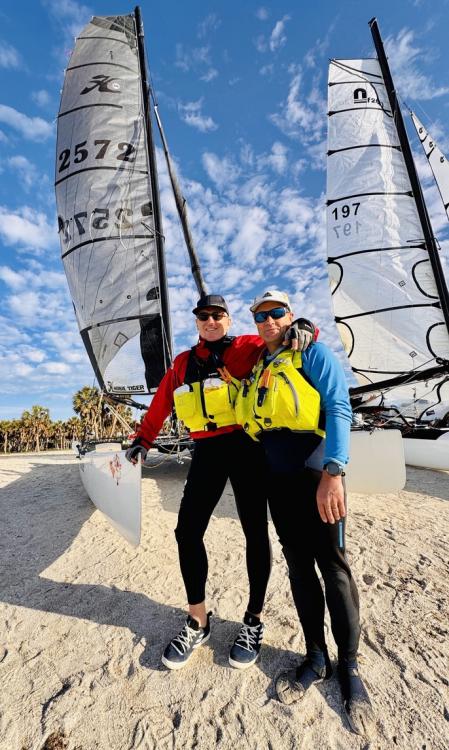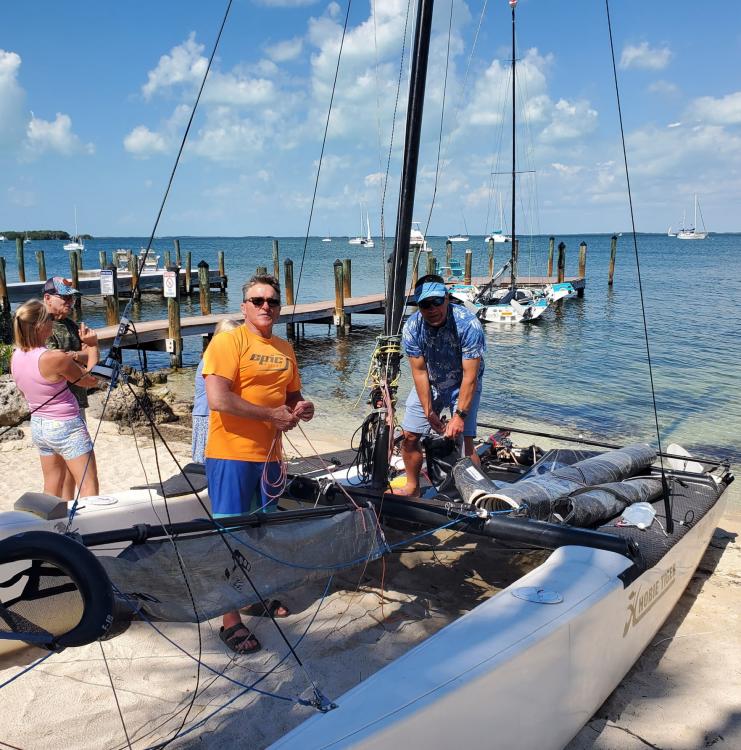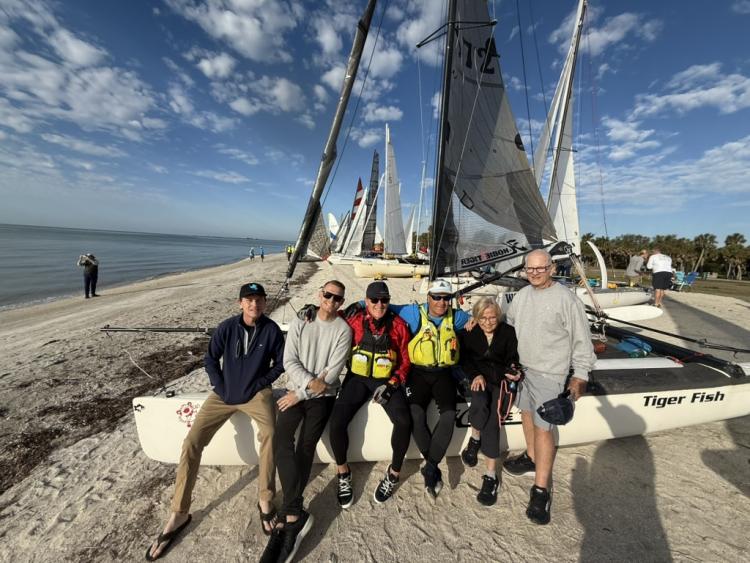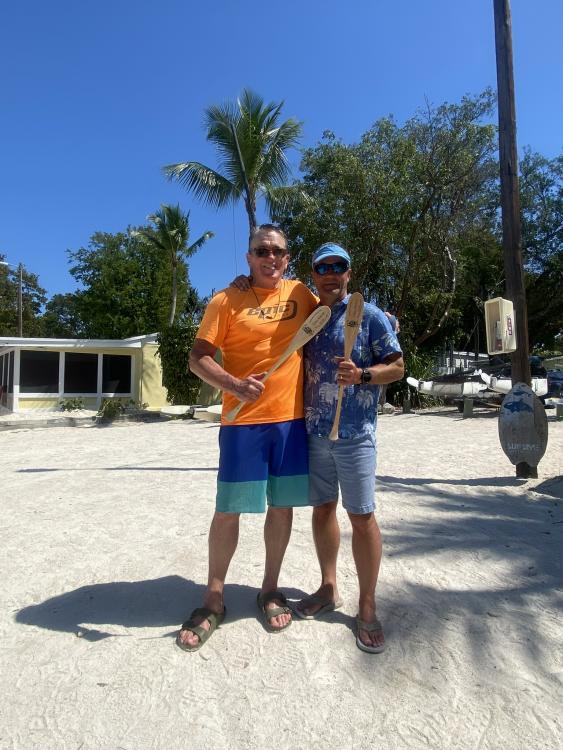Two Chesapeake Sailors Complete 300-Mile Everglades Challenge for the First Time
In the spring of 2024, in Miami for the Bacardi Cup, Jahn Tihansky was talking about this “Everglades Challenge (EC) thing.” Later, Bill Vickers (fellow Viper 640 skipper) and I were discussing ultra marathons and distance racing, and he brought up the Everglades Challenge, which he had been following for 15 years.
In October, Bill and I met at Eastport Yacht Club for a beer to discuss the potential event. Bill found an F-18 Cat in Norfolk for $12K, and my mind was set at about $10k less, seeing some videos of the traverse though Florida Bay (leg #4) where the dirt is close to the surface of the water, and those conditions would “smoke” a nice race rig. After our talk, Facebook Marketplace had a 2000 Hobie Tiger (Old school F-18 Class) for $3500. We got the boat for $2300. After rigging and re-building, we decided to take it for a sail.

WaterTribe’s rules for the 300-mile, expedition-style Everglades Challenge from Tampa Bay to Key Largo require proficiency with the vessel, two reefs, experience capsizing and recovering, many safety-related activities, and a list of safety gear that is very long.
Practice and prep
For practice, we paddled around one day with no breeze, took it out on a 45-degree, 15-plus-knot day trying not to freeze and that was it for Annapolis. Bill’s Viper was in Sarasota, so we took the Hobie there. We sailed the January Viper event and stayed over for a practice on the Tiger. Scott at Ullman Sails had put in two reefs in the main (per the rule), and we had rigged a reefing system. The third and final sail before the event was a disaster in 15 to 20 knots. The mainsail jammed, tore the reef points, broke some gear, and we barely made it back to the launch point: not the best day for our final practice.
The next month was all about navigation and studying the route, redoing the rig tune and reefing, figuring out what we would put on the boat, food supply, what we needed or did not need, and what the heck do you wear in conditions from 30 degrees to 80 degrees all in the same day. Bill owned the navigation and planning. He was the core to our safe passage.
Late February came, it was time to go to Florida. Bill went early; I drove down since we had to bring the boat back (assuming it made it to the finish). On Wednesday, I got to Sarasota to fix the Tiger from the January practice sail. Bill and his wife Becky scouted the checkpoints from Tampa to Key Largo along the 300-plus-mile trek, so we had some idea of the remoteness of the checkpoints.
Thursday, we took the boat apart and drove it to Tampa, parked it in front of our Airbnb, and loaded it up with all our gear. Everything we took had to fit through a six-inch inspection port; we had three in each hull. If it did not fit and was not on the required list, it did not go! That evening and guy showed up in our driveway and ask if we were doing the Everglades Challenge, as he had two guys staying with him doing the race.
Were we doomed?
We walked over to see these guys and wondered what we could learn from them. We met “Gamera” and “Chainsaw” (Matt and Mike on the Tornado). A requirement of WaterTribe is to have an official tribe name. They do not go by their given names for this event. We told them our real names and they said, “no, your race name.” So, Bill is “Gnixe”, and I am “Blofish” during this event, so we named the boat TigerFish.
These guys were long-time veterans of the event, had a customized Olympic Tornado on the beach that spent a few years getting fully optimized for the event. (Spoiler alert – they won the race.) They asked us; “Have either of you guys done the race?” We said, “no.”
“Where did you get your boat? Did you buy one set up for the race?”
“Nope. Facebook Marketplace”
“How much training time have you had on the boat?”
“About three hours… no maybe four hours.”
Gamera and Chainsaw were very gracious. They cut their eyes at each other and smiled with “knowing eyes” (these guys are doomed). They were super nice, but I might have given the same cautious welcome after knowing what I know now.

Getting rigged up
The next day we took the boat to the starting beach and rigged it up with the other 100-plus boats in the event. There were two Nacra 20 Carbon race cats, F-18s, Tornados, many fast boats on the beach, and all the small sail, peddle, paddle vessels that would take up to the full week to get to Key Largo. The “walkers by” on the beach all wanted to chat about the “Old Hobie Tiger.” It became a game when people asked us questions.
Standard answers: “No, never done it. “Facebook Marketplace,” “About three, maybe four times.” We were completely counted out.
By sundown, the boat was set. We picked up our car and ferry crew at the bus station (my son-in-law Shane and his brother Dustin), and we went to dinner. Bill’s mom Nel and her partner Bob were to be our ground crew. We could not accept any help at the checkpoints for this unsupported race, but Nel had supported Bill at many adventure races over the years, and she wanted to be part of it. At 85, she is a machine. She saw us off and was our ground support the entire way. I cannot thank her enough for her support.
The beach start
Not sure how much Bill slept that night, but I had a four-hour nap and was on my feet. Checking and rechecking my gear from 4 to 6 a.m., and re-packed everything once again. Everyone was up and ready to leave. We were off to the beach start. I handed the keys to Shane and said, “See you in Key Largo.” We raised the sails, took some pictures, hit the head, and before we knew it, we slid the cat to the water and pushed off at 8:30 a.m.
The first leg was light and flat out to the mouth of Tampa Bay. Gamera and Chainsaw (Tornado) lead us out of the bay with TwoBeer and MoreSailesed (Jeff and Jahn T. on a boat named (Spawn)) right behind. The rest of the fleet was split, and there were few boats with the three of us.
Spawn passed us soon on the shore, and we went out looking for breeze but took a wide pass to avoid the shoals off Anne Maria Island. Our kite was very small and required us to keep very hot angles to keep speed up in the light. These wide gybe angles caused us to sail long out and back to the beach trying to catch the two boats in front of us. We watched their huge kites walk away, but we could see that no one behind was gaining.
Surprise… we were in the hunt!
About 60 miles down the coast, the recent hurricanes had cut a new inlet to the intercoastal, and this was perceived to be the fastest route to Cape Haze Marina (Check Point #1). We watched Spawn sail in under kite, go in with no issues ahead. Obviously, those guys knew something we did not. Within seconds of trying to follow Spawn, the Tiger was hard aground in small surf (grounding #1).
Hearts racing, we went south to the next inlet two miles down the beach. We stayed close to the beach in the breeze and tried to cut the corner. Yep, on the bottom again (Grounding #2) within 30 minutes. We sailed the remainder of the intercoastal with no issues and found our way to checkpoint #1. Spawn was coming out a mile ahead, and the Tornado was long gone.
We entered the marina and went to down the wrong fairway and had to turn around to come back, burning time. Bill was ‘full-on’ at the checkpoint, wanting to leave quickly, after getting a lot of encouragement from the checkpoint volunteers. My sense of timing was a bit more casual. I did not realize we were in the hunt, Bill wanted to go. We jumped on the boat and took off.
We sailed south on the intercoastal about five miles and took a hard turn to go out another inlet at sunset. You guessed it, we found the bottom again (Grounding #3) on the beach exit. After learning our lessons on how to find the bottom, Bill wanted to make sure we did not run aground on Johnson Shoals, a long-dredged inlet way out into the Gulf, as we were starting to see 10 kts on the speedo.

Time for a short (uncomfortable) nap
The breeze picked up to 15-plus kts and we were flying down wind around 10 p.m. when we decided to try to take some breaks after going all day. Bill pulled out the shelter from our required gear and wrapped it around himself to try to stay warm and maybe nap. The waves were getting bigger, and about every two minutes, a wave would hit the bottom of the trampoline and explode up like a geyser. Bill was trying to find comfort and he stayed there for an hour or so hours. It looked miserable.
After watching the geyser for a couple hours, it was my turn. I laid over top of the dry bags with our gear in them at the forward part of the trampoline. This worked to keep me out of the geyser, and I literally passed out next to Bill for an hour or longer.
Before we went offshore in the dark, we had agreed “No kite at night.” When I woke up, the coast to the east was far away. Bill said, “The coast had gone east, and you were actually snoring, so I did not want to gybe and wake you up.” After looking at the GPS we were 20-plus miles out. This was the fast route in the breeze, a bit unnerving with no moon and limited navigation tools, yet turns out we had some gains in the early morning.
Mud flats at checkpoint #2
Morning came and we were in striking distance of Check point #2 South of Naples. Bill’s planning and GPS tracks allowed us to pick our way through the mangroves. We found Checkpoint #2 at Chokoloskee at 11:08 a.m. At high tide it is a sail in and sail out; not for us. As the tide goes out, it is a mud flat. We were only able to get the boat within 50 yards of the shore in the mud.
We grounded the Tiger by shoving the blades in the goo and slipped off into thigh high mud and water. Nel and Bob let us know where we were. “What – we are in third place overall and leading our division?” I think the race officials were a surprised as we were.
We got a Coke at the little store and ran back to the mud. We had a strong flood tide against us. We paddled hard and navigated to make headway, finding the shallow banks once again. Tacking a catamaran in a tight channel with onsetting tide was a challenge and took hours, tacking a lot and paddling hard, but it was here where we developed more of a lead on those behind.

Dolphins, groundings, and gators
Once out of the Mangroves, it was a 70-mile Southwest fetch to Cape Sable, a hard left south and then find Flamingo, Checkpoint #3. The horizon would show a point of land, and we would convince ourselves it was Cape Sable, and then a new land point would appear behind it. Finally, it was there, and we turned due west to Flamingo—ot before seeing some dolphins welcome us to Cape Sable.
We navigated into the cut toward the marina after running aground another couple times (we stopped counting the groundings). We had a few disagreements over navigation as it was getting dark, but Bill always found the correct way. We signed in at Checkpoint #3 around 8 p.m. The ground crew showed us to the head. It was here Bill was wondering maybe it was time to get warm and take a nap. “OneEyedJake” (Andy) encouraged us to continue because of the gators and mosquitoes at CP#3, so we asked for a coffee and got two piping hot cups. They confirmed we were solidly in third place about one hour back from Spawn; the Tornado was another two hours ahead of them, so Andy encouraged us to “get going.”
We knew the Hobie 16 was behind us, but we had no idea how close. Back to the boat. Bill has quite the memory of exchanging out the bow light hanging with his feet in the water over the narrow bow of the Tiger, remembering there were four gators present in this marina—“Lift your feet buddy.”
Bill had seen Florida Bay the previous week, so he had some idea of what it looked like, at least from Key Largo. We decided to take the northern of the three routes, as it was the shortest with the wind on the port quarter.
Navigating in the dark, the Twisty Mile, and senses on overload
Out the inlet and a hard left turn to Key Largo. We put on headlamps to help luminate the channel markers as they appeared. The channel is about 30 feet wide and four feet or so deep. The water to the sides of the channel could be inches to feet deep, with no idea of what was next. The channel markers are 4x4 timbers with a reflector on top pointing to the channel; red and green lights don’t really exist on Florida Bay.
It was blowing about 15 kts steady on the beam. Tiger was going fast. Rudders and boards down it screamed towards the first channel markers. Bill would find the marker, and I would steer to what I thought was the channel. Our GPS systems were compromised by this time due to water on the touchscreen and constant splash over the trampoline. The touch screens on the iPad and phone Navionics kept constantly freezing. You could see the boat on the chart, but not scroll or move it around, and there was no way to see the channel turns ahead.
The first few miles we did okay staying in deep water, but it got interesting. The channel started moving left and right, perhaps that’s why it was called “Twisty Mile,” and we could not keep up with the changes. Once we got in shallow water, we would pull up the boards and the rudders would kick up. Not a big deal for running aground, but the weather helm got extremely hard.
With the wind on the port beam/quarter, the main was 100-percent loaded, and the helm got intense. We would go back and put the rudders down, while we fought the boat and steered to the next mark, Bill all the time straining to see the next marker, which got even harder because of all the birds flying in front and around us. Anytime, we took the headlamp off the marker to fix the rudder, the boat would turn up and yes, shallow water again.
One time the rudder hit and kicked up in a puff, and we hit a channel marker at over 10 knots. The old Tiger took the hit hard, bent the bow sprit a bit, spun around 180 degrees and was ready to go again. We jumped off pushed her back around, and we were off again. The coffee by now was wearing off, but our senses were in overdrive from the constant challenges.

Almost lost Bill… and wow, what a finish
About 30 minutes later screaming in the channel, we hit something in the and she jumped out of the channel and found dry land. We got off in ankle-deep water and pulled her around again. The wind caught in the main and off we went (I thought it was ‘we’). I looked back to see Bill’s headlamp stationary, and I was alone.
The Tiger was easy to find dirt again, and Bill ran the 50 yards up to join the ride again. We fought our way through a for what seemed like 30 minutes but was more like three hours to a Bay and decided to drive south to pick up the last few miles of the less adventurous intercoastal.
We navigated the four miles northeasterly to an old railroad trestle and bore away to the finish. As we approached, saw the Tornado on the Beach and Spawn tied up on the pier. The Tiger hit the beach at 1:12 a.m. Monday morning. Bill’s Mom and Bob were there along with my wife, daughter,r and son-in-law.
We finished first in division and set new division course record by two hours!
During leg #3 we discussed the race, and it was said, “do not think we will do this again.” We were exhausted, wet, and cold. But like all endurance racers, we have not stopped talking about modifications to the Tiger and gear for next year, ever since we got off the water. We could be a lot faster!
~By Dailey Tipton
Bill Vickers (60 yrs) and Dailey Tipton (61 yrs) both race in the Annapolis Viper 640 fleet. Both are accomplished endurance athletes with racing/sailing resumes that date back to the 1970s.
Learn more about the Everglades Challenge. Hear Jahn Tihansky's talk about the event at the Annapolis Spring Sailboat Show April 25 at 3 p.m.: scroll down for details.
Find more racing stories.




